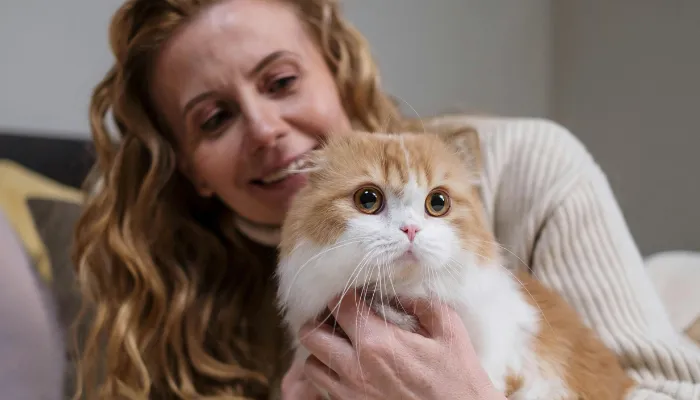How Do Cats Say “I Hate You”? Children often talk about their pets, often cat owners say that their cats do not love them. Cats have fancy ways to caper around their emotions and their actions can peck at animal love.
Every owner must know these signs ranging scraping, staring avoidance, hissing and scratching, which are really very important. Using a cat translator can also help interpret these behaviors. It can help one understand if the furry friend is really angry with the owner or just setting up boundaries. This helps to strengthen your relationship further.

Signs Your Cat Might Be Saying “I Hate You”
How Do Cats Say “I Hate You”? Cats may not use words, but their actions speak volumes when they’re upset or feeling distant from you.
1. Hissing and Growling
The first indicator that should concern you is hissing or growling, as it indicates that the cat is displeased. Hissing and growling is a vocalization that represents a warning that one or many aspects of its environment has brought about annoyance or irritation.
2. Swatting or Biting
Swatting, the act of pushing one’s hand in the air with great force, can be performed by a cat as an indication of anger. Biting can be taken an affirmation of love, but under stressful situations, a cat can bite in a non playful manner which is suggestive of animosity.
3. Ears Pinned Back
One clear snippet of information that points to the head being one of the most crucial parts of communication for a cat is when a cat pushes it’s ears flat against its skull where both ears are at rest on its head.
4. Tail Flicking or Lashing
Fast movement of the tail and loud thumping noises are features of hyperactivity. One or more tails flapping on the body at a feline’s fast pace can be interpreted as the cat feeling angry or being in an aggressive combat mode after being.
5. Avoiding You or Hiding
When a cat no longer wants to be approached by a person, it will begin to hide underneath various pieces of furniture that can provide concealment. If a cat’s behavior includes hiding and avoiding a person frequently, especially in the presence of that person, it points to feelings of disappointment.
6. Ignoring You Completely
With a sudden change in engagement where the individual involved simply ignores the other suggests a state of despondency, where the individual is deeply aggrieved.
7. Sudden Litter Box Issues
Sudden behavioral complications should be looked into due to the possibility of them being linked towards depression, loss of interest, and general upset feeling.
Knowing the expressed emotions will allow you take necessary steps to rebuild trust and strengthen bonds with your cat.
Why Do Cats Express Dislike?
How Do Cats Say “I Hate You”? Understanding the reasons behind their behavior is just as important as recognizing the signs. Here are some triggers that might be making your cat seem irritated:
- Stress or Anxiety. If you get a new pet, or there is a change in the house, or something is too loud, your cat might feel stressed without you noticing.
- Overstimulation: During playtime or petting, a cat might feel too much and end up acting aggressively or avoiding further physical contact.
- Health Issues: Your cat may misbehave due to an underlying severe problem that causes pain or discomfort.
- Lack of Trust: Whenever your cat feels scared and betrayed, she tends to slightly move away from you.
Identifying these triggers allows you to create a more comfortable and stress-free environment for your cat.
How to Respond When Cat Says “I Hate You”?
How Do Cats Say “I Hate You”? Strive to tackle your cat’s presumably problematic behavior mindfully and with sufficient grace. Here’s what you need to do:
- Give Them Space: Allow your cat to dictate the pace by which she wishes to interact with you.
- Identify Triggers: Try to reason with yourself about what could be stressing out your pet and work towards reducing it; if you know the causing factor, then take it out fully.
- Provide Enrichment: There should be an abundance of toys, scratching posts, and safe areas to allow boundless exploration.
- Consult a Vet: Whenever there’s sudden or unexplained behavioral changes, a vet consultation is an option to rule out medical issues.
- Rebuild Trust: Take time off from your busy schedule to spend playful bonding time with your cat. Trust and bond can be rebuilt through gentle love and treats.
By addressing their needs with patience and care, you can turn your cat’s negative reactions into signs of trust and affection.
Common Misconceptions About Cat Behavior
A cat moves its body in a way that might seem hateful, but it is only trying to communicate. For example:
- Purring Isn’t Indication Of Happiness: Cats can purr even when stressed or in pain.
- Flicking Of The Tail Doesn’t Necessarily Means The Cat Is Playful: A cat can also flick its tail as a sign of vexation.
- Avoidance Isn’t Forever: Cats will not forever avoid you, no matter how distant a relationship feels at any point in time.
With these misconceptions in mind, one can bond with their cat more effectively by correcting appropriate behavior towards their genuine needs.
Conclusion
How Do Cats Say “I Hate You”? Cats can suggest dislike via avoidance, hissing, scratching, or destruction, but such acts stem more from stress, anxiety, or discomfort than from real animosity. By learning their triggers, caring for their environment, and establishing boundaries, their relationships can be mended.
With gradual trust restoration and positive reinforcement combined with flexibility offered, the negative responses can be converted to affection over time, enhancing the bond between humans and their feline friends.
